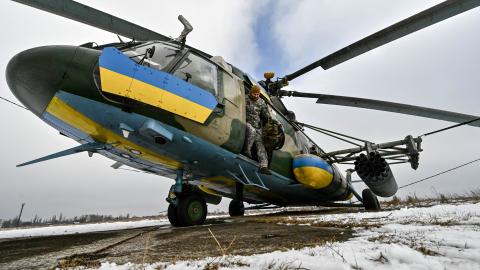Below Hudson Senior Fellow Can Kasapoğlu offers a military situation report about the war in Ukraine.
1. Battlefield Assessment
According to the Ukrainian General Staff, as of February 2, 2024, Russia has lost around 387,000 troops since it began its invasion of Ukraine. According to United Kingdom intelligence, moreover, between February 24, 2022, and January 25, 2024, Russian ground forces are estimated to have lost approximately 2,600 main battle tanks (MBTs) and 4,900 armored combat vehicles (ACVs) in the war.
The same UK intelligence report noted, however, that the Russian industrial base is capable of compensating for these material losses by generating up to 100 main battle tanks per month. Combine this manufacturing resiliency with the Kremlin’s indifference to human losses, and it is easy to understand how Russia’s push for the parts of Luhansk and Donetsk Oblasts that remain unoccupied is leading to increased casualty counts.
Over the last several days, Russian forces reportedly advanced along critical fronts such as Avdiivka, Sieverne, and Kupiansk, where positional engagements continued at multiple hotspots along the lines of contact. On the southern front, Ukrainian combat formations conducted some successful engagements, mostly thanks to well-equipped infantry units augmented by drone warfare assets and heavy armor. The area around Bakhmut witnessed heavy clashes over the last week.
Russian aerial attacks also continued in the first week of February. As they have in previous drone strikes, salvos of Iran-supplied Shahed baseline loitering munitions targeted Ukraine’s defense industrial base, critical infrastructure, and population centers. A Russian strike on an electrical substation in Kryvyi Rih left multiple households and hospitals without power and trapped several miners under rubble. Russian forces also directed another heavy shelling at Sumy in northeast Ukraine. According to Ukrainian sources, Russia targeted five neighborhoods in the oblast in more than 20 aerial attacks.
With a law lowering the age for military mobilization progressing through parliament, Kyiv is gearing up to activate an infantry-focused force to hold the line in the face of the growing Russian threat. According to Major General Viktor Nikoliuk, the commander of training at Ukraine’s Ground Forces Command, the new mobilization law would allow the military to train up to 500,000 additional troops. The commander’s remarks highlight Ukraine’s urgent need for new fighters.
2. Breaking the Stalemate: General Zaluzhnyi’s Take on the Ongoing War
In an essay this month, General Valerii Zaluzhnyi, the commander-in-chief of the Armed Forces of Ukraine, outlined several conditions he deemed critical to the success of Ukrainian combat operations. His list was comprehensive: achieving air superiority to facilitate an effective ground warfare push, denying Russian combat formations the ability to conduct offensive operations, enhancing Ukrainian mobility while constraining Russian maneuver warfare, establishing safe access routes to critical territory and key locations, preventing Russia from recapturing lost terrain, and hindering Moscow’s operational efforts.
General Zaluzhnyi further argued that Ukraine should develop long-term plans to augment its structural capacities as a well-functioning state: expanding its defense-industrial base, investing in research and development and human capital, improving the Ukrainian Armed Forces’ ability to assess security needs, enhancing Kyiv’s institutional and regulatory frameworks, and pushing for new, more effective sanctions against Russia.
In his editorial, the general also emphasized the importance of technological innovation in countering Russia’s armed forces. Bolstered by lessons learned on the battlefield, his argument highlighted the propitious cost-benefit ratio of new technological tools such as unmanned and robotic warfare systems. By rapidly incorporating these smart assets, Zaluzhnyi argued, Ukraine has been able to maximize its combat performance and use minimal resources to cause significant damage to Russian units. In Zaluzhnyi’s calculus, these combined dynamics have the power to shift the balance of power in Ukraine’s favor within months.
However, the general’s op-ed suggested that Kyiv needs to go a step further to break the existing stalemate. Zaluzhnyi contended that Kyiv must adopt a new philosophy for its military doctrine and combat operations. Such a change should include employing the aforementioned cyber-robotic assets to engage in a multidomain war—a war that targets Moscow’s economy, furthers its isolation in the international financial system, extends into psychological warfare, and enables new human-machine teaming missions on the battlefield.
According to General Zaluzhnyi, Ukraine’s new combat strategy and concepts of operation (CONOPS) should involve advancing on multiple lines of effort to create a “digital battlefield.” In this sphere, Ukrainian forces should control the cyber-electromagnetic spectrum along the front lines, bolster their strikes with unmanned and cyber assets to minimize casualties, and inflict heavy damage on important Russian military assets.
3. Ukrainian Unmanned Surface Vehicles (USVs) Strike Critical Russian Naval Platforms in Crimea
For Ukrainian forces targeting Russian-held Crimea, February started with a bang—one that struck strategic Russian platforms docked in the occupied peninsula. Footage released by Defense Intelligence of Ukraine shows that a Ukrainian robotic warfare deterrent successfully struck and destroyed the Russian Tarantul-class missile corvette Ivanovets near Lake Donuzlav. The incident marks a strategic loss for Russia’s Black Sea Fleet, as the destroyed corvette was one of the few units from Russia’s much-lauded Project 1241.1 still in service. According to reports from UK Secretary of State for Defence Grant Shapps, Ukraine has destroyed around 20 percent of Russia’s Black Sea Fleet over the last four months.
4. The Russian Rosgvardiya Is Subsuming Wagner Detachments into Its Ranks
According to UK defense intelligence, the Russian National Guard (Rosgvardiya) is implementing President Vladimir Putin’s December 2023 decree that allows it to organize paramilitaries, and is subsuming assault detachments from the Wagner private military company into its own Volunteer Corps. Russian military blogs and embedded Telegram channels confirm this claim.
This development shows that Putin does not want to leave Wagner solely in the hands of Minister of Defense Sergei Shoigu, but seeks instead to burnish the profile of the Kremlin’s favorite general, Viktor Zolotov, the Rosgvardiya’s director. The October 4, 2023, edition of this report discussed this rivalry in depth.
First established in 2016 and 2017 as a special unit tasked with combating domestic terrorism and extremism, the Rosgvardiya soon morphed into a strategic instrument for the Kremlin. Now the National Guard operates more like a Praetorian guard for Putin’s regime.
It remains to be seen whether the Wagner units under Rosgvardiya’s control will be deployed to Africa, where they would likely take control from Wagner of the Kremlin’s efforts on the continent.














